Foie gras is a dish of choice, considered one of the jewels of French cuisine. For gourmets with refined taste buds, it is the local product par excellence that is savored during the holiday season. But how do you know which type of foie gras is right for you? In this buying guide, we will present the best foie gras of the moment.
Here is our commitment, to make sure that we provide the best user experience and content quality:
You can support us by using our links to make your purchases (at no extra cost to you)! This sometimes earns us a commission which allows us to remain independent. More about us
Our selection
"Would you like to taste a noble gastronomic product that is the pride of an entire region? Try the whole foie gras from Périgord from…"
"If you are looking for delicious, easy to prepare, easy to serve and affordable foie gras, then the I.G.P. Sud-Ouest duck foie gras from Nos…"
"For the holidays, here is an opportunity to prepare delicious dishes at home. The half-cooked poached duck foie gras 440 grams is the essential ingredient…"
"Pierre de Chaumeyrac's block of duck foie gras from the Southwest with pieces is a simply delicious, unctuous semi-cooked foie gras recipe with perfectly balanced…"
"If you want foie gras, but you want to go a bit beyond the usual, choose this 150g whole goose foie gras. It offers an…"

Would you like to taste a noble gastronomic product that is the pride of an entire region? Try the whole foie gras from Périgord from the brand L'Origine du Goût, you won't be disappointed.
12 £ on E.LeclercWhole foie gras is considered the best of its kind, especially if it is prepared from goose foie gras. And this is the case of the whole goose foie gras from Périgord 125 g: it has a fine taste, a smoothness and a delicacy that will seduce the most demanding amateurs in the matter. This product is made of whole goose foie gras, salt and pepper.
To taste it, you must accompany it with country bread or toast that will not hide the taste. As for the drink, choose a white wine, sweet or semi-dry. Try a Monbazillac Château Combe des bois or Clos Fond de Mingue. A white Latitude 44 demi-sec will also be perfect.
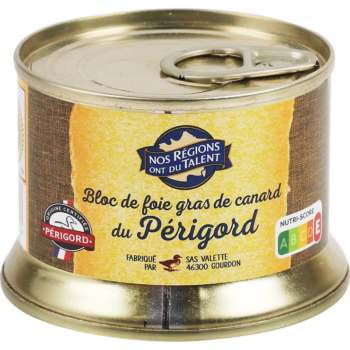
If you are looking for delicious, easy to prepare, easy to serve and affordable foie gras, then the I.G.P. Sud-Ouest duck foie gras from Nos Régions will suit you perfectly.
4,76 £ on E.LeclercThis block of duck foie gras I.G.P. Sud-Ouest is a real jewel at a very low price: it materializes all the know-how of local producers. It is a preparation concocted from duck foie gras rigorously selected to give an intense flavor, a beautiful yellow-orange color and an irreproachable texture.
This block of foie gras is of first quality and perfectly traceable, thanks to the IGP Duck with foie gras of the Southwest. It has been produced with ducks raised in the open air for 10 weeks, fed with cereals, then force-fed with corn for 2 weeks. This foie gras is offered in a 130 g can which will suit 2 to 3 people depending on your menu. Serve it at room temperature, which means that it must be taken out of the refrigerator between 15 and 30 minutes before serving and tasting it.
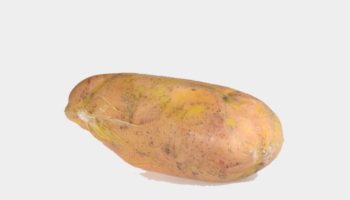
For the holidays, here is an opportunity to prepare delicious dishes at home. The half-cooked poached duck foie gras 440 grams is the essential ingredient to offer a refined and tasty menu to the whole family.
48,64 £ on pourdebon.comThis half-cooked Duck Foie Gras originates from the Landes region. It comes from ducks aged at least 91 days, raised in the open air and fattened with corn seeds. Presented in vacuum-packed format, this product can be kept in the refrigerator between 2 and 4°C.
This Montauzer product is prepared in advance to optimize the time spent in the kitchen. Thus, this duck foie gras is already seasoned with salt, pepper and port before being cooked. You will be pleasantly surprised by the flavors it gives off. It is a local product that has been delicately enhanced by Montauzer.
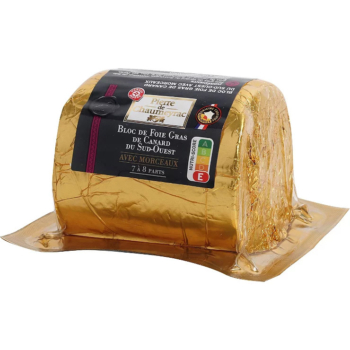
Pierre de Chaumeyrac's block of duck foie gras from the Southwest with pieces is a simply delicious, unctuous semi-cooked foie gras recipe with perfectly balanced flavors.
11,80 £ on E.LeclercPierre de Chaumeyrac's block of duck foie gras from the Southwest with pieces is a preparation that contains duck foie gras and 30% pieces as the main ingredients. It is a product that is particularly appreciated for its flavor, which is both delicate and creamy. The professionals who have already tested it (including the Que Choisir team) have perfectly appreciated their tasting: this foie gras offers a very melting texture, it is moderately salty with a very interesting acidity note.
The product also has a very good presentation with its homogeneous color that turns golden, no holes or blood stains to be deplored, without forgetting its beautiful nose with a nice smell of liver not too pronounced. We could however reproach it for being at the limit of the water content tolerated in the recipes of the blocks, and for presenting a percentage of incorporated pieces a little less than the 30% announced, but it remains an excellent product.

If you want foie gras, but you want to go a bit beyond the usual, choose this 150g whole goose foie gras. It offers an exceptional taste, a little different from duck, but even more delicious. It is highly recommended for its fine flavor and delicate texture.
29,04 £ on pourdebon.comPresented in a 150 g jar, this whole goose foie gras comes from geese from the Dordogne. It is made for 1 to 2 people. It is a preparation that is composed of 98% goose liver, it has been lightly peppered to accentuate its extremely melting and salty taste to make you experience a gustatory pleasure never felt before.
The animals of the Pleinefage farm are raised in the open air to obtain smooth and tasty meat, and this is also true for its geese. With this preparation, Tribier-Pleinefage offers you a real treat for the taste buds, a very original alliance of taste. This preparation is to be eaten well chilled, as an aperitif or as a starter with green salad, nuts, black ham or stuffed neck. You can also accompany it with a good sweet or semi-dry white wine. This product can be kept up to 4 years in a cellar or a not too warm cupboard.

For the end of the year celebrations, get ready to treat your taste buds. With Terres d'Adour, you will have foie gras for all tastes. The extra gourmet raw duck foie gras "special preserve" is a testament to this.
25,20 £ on pourdebon.comProduced from the Terres d'Adour, in the Landes region, this foie gras comes from ducks with the good taste of the land, which grow slowly and are fed in the open air. This allows to have, in mouth, tasty tastes with surprising flavors. To facilitate its preparation, this product is deveined and vacuum-packed in its packaging. Available in weights from 480 to 520 g, it is a block of raw foie gras "Special canning" which will sublimate the gastronomic type of cooking.
This vacuum-packed product can be kept in a cool place and consumed up to 15 days after reception. It can be sterilized, as well as cooked for a long time at high temperature without risk of melting, to optimize the preparation of your jars of canned foie gras with rare flavors that can be frozen if needed.
Any specific needs?
Your guide :
Rate this buying guide :By rating this buying guide, you are helping us to reward our best writers. Thank you!
| THE BEST | LESS EXPENSIVE | TOP OF THE RANGE | EXCELLENT | Alternative | Cru Deveined "Special Canned" | |

In accordance with our commitment, this buying guide does not contain any sponsored products. |
 8/10 |
 7/10 |
 9/10 |
 6/10 |
 7/10 |
 8/10 |
| OUR SELECTION |
L'ORIGINE DU GOUT - Whole goose foie gras from Périgord (125 g)
|
OUR REGIONS HAVE TALENT - Block of foie gras duck I.G.P. Sud-Ouest (130 g)
|
MONTAUZER Half-cooked foie gras
|
PIERRE DE CHAUMEYRAC - Block of duck foie gras with pieces (300 g)
|
TRIBIER-PLEINEFAGE - Whole goose foie gras (150 g)
|
Terres d'Adour Foies Gras Cru deveined
|
|
Would you like to taste a noble gastronomic product that is the pride of an entire region? Try the whole foie gras from Périgord from the brand L'Origine du Goût, you won't be disappointed.
|
If you are looking for delicious, easy to prepare, easy to serve and affordable foie gras, then the I.G.P. Sud-Ouest duck foie gras from Nos Régions will suit you perfectly.
|
For the holidays, here is an opportunity to prepare delicious dishes at home. The half-cooked poached duck foie gras 440 grams is the essential ingredient to offer a refined and tasty menu to the whole family.
|
Pierre de Chaumeyrac's block of duck foie gras from the Southwest with pieces is a simply delicious, unctuous semi-cooked foie gras recipe with perfectly balanced flavors.
|
If you want foie gras, but you want to go a bit beyond the usual, choose this 150g whole goose foie gras. It offers an exceptional taste, a little different from duck, but even more delicious. It is highly recommended for its fine flavor and delicate texture.
|
For the end of the year celebrations, get ready to treat your taste buds. With Terres d'Adour, you will have foie gras for all tastes. The extra gourmet raw duck foie gras "special preserve" is a testament to this.
|
|
|
Composition
|
Whole goose foie gras, salt and pepper
|
Duck foie gras, water, Armagnac, salt, pepper, sugar
|
Duck foie gras, salt, pepper and port wine
|
Southwest duck foie gras, pieces of duck foie gras from the Southwest 30%, water, salt, Porto, Armagnac, pepper, sugar, preservative : E250, antioxidant : sodium ascorbate.
|
Whole goose foie gras (98%), salt and pepper
|
Raw duck foie gras
|
|
Preservative
|
|
|
|
|
|
|
|
Flavour
|
Fine, unctuous taste and unequalled delicacy
|
Old-fashioned with a lightly peppery note
|
Smooth, medium saltiness
|
Smooth with a not too pronounced "liver" note, medium salty with a touch of acidity
|
Classic, balanced and tasty note, slightly peppery
|
Rare flavors of foie gras
|
|
Origin of main ingredients
|
Périgord
|
Perigord
|
Southwestern
|
From the Southwest
|
Périgord
|
Landes
|
|
Portion
|
1 to 2 person(s)
|
1 to 3 person(s)
|
4 to 5 people
|
7 to 8 people
|
1 to 2 person(s)
|
4 to 5 people
|
Help us improve this table:
Report an error, request the addition of a feature to the table, or suggest another product. Thank you for your kindness!
We spend thousands of hours each year studying the major specialized websites, analyzing products of hundreds of brands and reading user feedback to advise you on the best products.
We are a product review company with a single mission: to simplify your buying decisions. Our research and testing helps millions of people every year find the best products for their personal needs and budget.
To support us you can: use our links to make your purchases (which often earns us a small commission), share our articles on social networks, or recommend our site on your blog. Thanks in advance for your support!
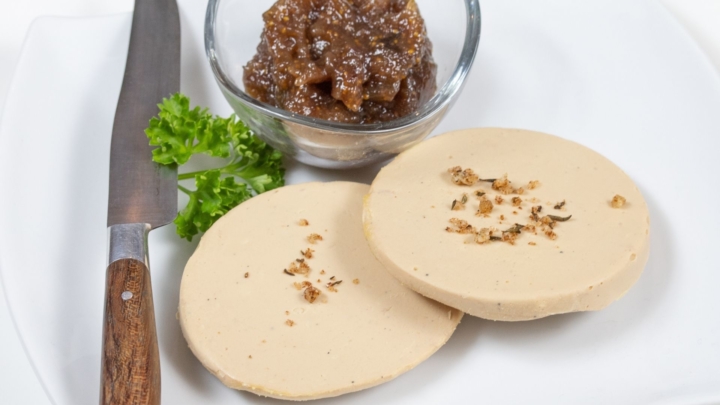
A good whole foie gras should simply consist of a whole liver (whose lobes have been carefully separated before cooking), salt and pepper. For the block of foie gras, only a very small amount of water, nitrite salts and sugar should be added. Avoid products that contain artificial flavors, alcohol such as port or armagnac or antioxidants such as sodium ascorbate or ascorbic acid (E300).
A good foie gras does not need any of these ingredients which are often added simply to mask a bad flavor. The best chefs use only the best foie gras, then complement it by serving slices or perhaps a terrine alongside delicacies like truffles, figs or a simple green salad with a sweet white wine like Sauternes.
Always choose a foie gras with a label of authenticity. Selecting products labeled "foie gras du Sud-Ouest", "foie gras du Périgord", "foie gras Label Rouge" or bearing the "oie du Périgord" appellation stamp is paramount. Although this cannot guarantee that the product has an excellent taste, it does reassure that the foie gras has been produced according to precise and demanding specifications (strict hygiene standards, ducks and geese have been raised in freedom, locally and with a diet rich in corn etc).
The products made in the South West of France often benefit from a local know-how that is passed on from generation to generation. These producers prepare raw foie gras with love, in all simplicity, according to family recipes, which results in a very special product that does not require unnecessary spices to enhance its flavor.
Avoid choosing a foie gras whose label says "Produit de France", "Fabriqué en France" or "Pays d'Origine France". These are usually low-end products that do not meet any particular specifications or that only meet minimal criteria - or they are made from foie gras imported from another country in the world (mainly Central Europe) and packaged in the UK. Similarly, avoid products labeled foie gras pâté that may contain other, less expensive meats alongside the foie gras.
Medals and awards can provide a good indication. Again, we could debate how these are actually awarded at the various agricultural fairs. The winner sometimes depends on the size of the company, the managers' membership in professional organizations, or their involvement in the organization of the fairs. Nevertheless, the judges are usually both passionate about the products and qualified to make the decision.
So, again, no guarantees, but if two products are the same price, then the one with the medal is probably the better of the two.
If you trust your butcher or deli, ask them for advice. For example, you can ask them about the texture of the product (how smooth is it?), production methods, and its popularity with their customers. Also, don't hesitate to visit the websites of the major foie gras distributors, which give very good advice on how to choose your foie gras.
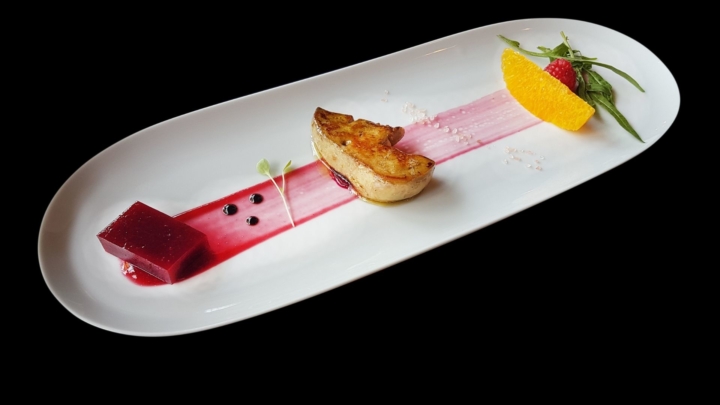
Foie gras is sold either whole, in pate or in mousse. It is then served in terrines or as a hot appetizer or main ingredient. It is extremely fatty, with a very rich buttery flavor and a smooth texture.
To make foie gras, duck or goose liver must be enlarged to nearly 10 times its size. This is accomplished by force-feeding the animals with corn through a feeding tube. This practice, known as force-feeding, originated with the ancient Egyptians in 2500 BC when they force-fed birds to fatten them for consumption. in the UK, the law states that "foie gras is part of the protected cultural and gastronomic heritage of France."
Gavage is a controversial technique, as it is considered a type of animal cruelty that goes beyond simply raising animals to slaughter for food. The culinary community is somewhat divided on the issue, with some chefs refusing to serve foie gras. Foie gras producers argue that it is possible to practice humane force-feeding: geese and ducks are migratory birds that feed in large quantities prior to migration, which in effect means that the birds are naturally fattening. By timing the slaughter with these migration patterns, it is possible to produce a version of foie gras known as "goose foie gras," which some consider an "ethical" or "humane" form of foie gras.
Well, it's still foie gras, but it's less refined than already prepared and cooked foie gras. Raw fois gras can be recognized by the red veins that run through the liver. This is one of the reasons why ordinary consumers hesitate to buy it: the fear of not knowing how to prepare foie gras properly and not getting the desired result when serving is a real brake. It is true that it is necessary to know how to devein it so that it is presentable and to prepare it well so that it releases all its taste. Chefs can use raw foie gras to make sauces, or they prepare the raw liver and turn it into a more refined pâté.
Take the raw liver out of the refrigerator an hour before you start working with it. Separate the two lobes with your hands: you will see a large nerve connection between them. The nerve/vein network runs down each lobe to a depth of about 1/2 centimeter. Starting with the largest lobe, grasp the nerve between two fingers and pull gently but firmly to remove it from the lobe, being careful not to tear the flesh. You can incise the liver along the path of the nerve with the tip of a sharp knife; use a cloth to better grasp the nerve. Repeat the procedure for the small lobe. Do not attempt to remove all the small nerves or veins: the texture and aesthetics of the foie gras must be maintained.
Note that the preparation process is less complicated if you want to serve your foie gras cooked: the key words here are high temperature and short cooking time to sear the slices of foie gras. It will also be easier to devein the liver since it will have to be sliced before being sautéed. Here is a very simple preparation of raw foie gras:
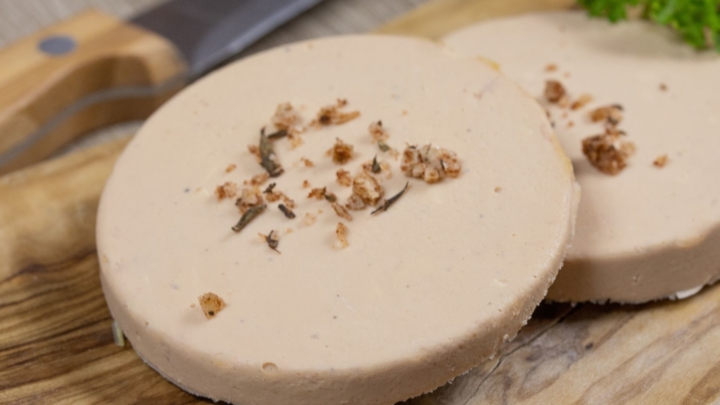
Whole duck or goose foie gras is a cooked and preserved product, generally in blocks, and contains no additives or mixtures. It comes from a single foie gras, i.e. a lobe or part of a lobe of foie gras. Whole foie gras is easily recognized by its beautiful uniform coloring when cut.
It must be seasoned before cooking and according to strict regulations. Indeed, it can only contain authorized seasonings: salt, sugar, spices and aromatic plants, brandies, liqueur wines and wines. The whole foie gras is the best you can find in the matter, so it is also more expensive than the other types of preparations.
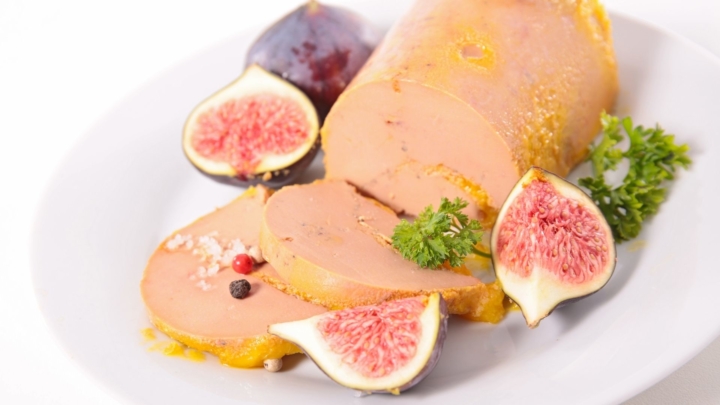
The block of foie gras is composed of small pieces of duck or goose foie gras whipped and condensed into a block. It is thus a preparation made from emulsified foie gras well seasoned.
The block of foie gras can also contain pieces of lobe of foie gras which will be clearly visible at the cut and which must be mentioned in the name of the product (block of foie gras with pieces). Traditional recipes include the addition of truffles.
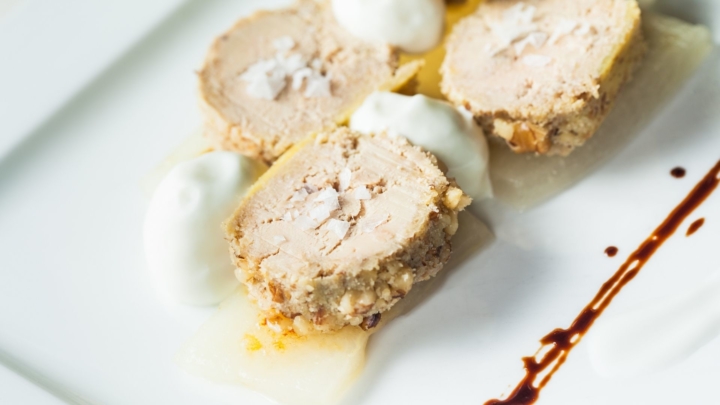
Foie gras mousse is a preparation made from pieces of foie gras that have been ground or puréed into a creamy mousse. This recipe is composed of 50% foie gras seasoned with port and cream.
Generally, foie gras mousse is available in tube or string format to be served in canapés or processed for sauce design.
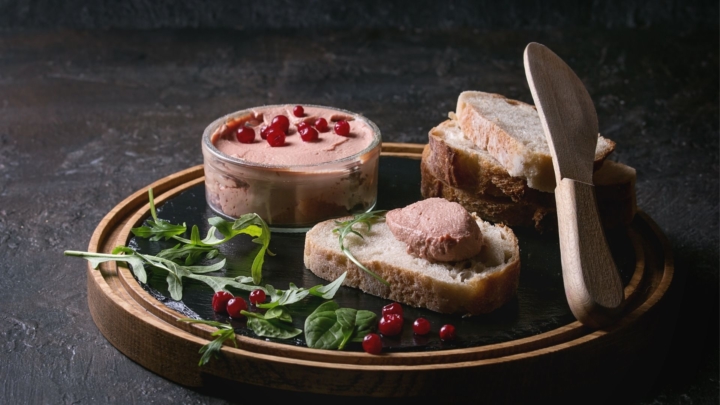
Foie gras pâté is a rich, creamy paste made from goose or duck foie gras. It is a preparation of foie gras combined with other meat products, such as pork, duck or veal. The content of the foie gras is lower than that of the other products.
It is a smooth, homogeneous block similar to a spread, which is excellent when served with crackers or toast.

Pasteurized semi-cooked foie gras is partially cooked and preserved to preserve as much of the original consistency, texture and flavor as possible. Semi-cooked foie gras is subjected to a temperature between 70 and 85°. This type of foie gras has a reputation for freshness that will appeal to all palates. The fact that it is cooked for a shorter period of time allows it to keep all its flavors and it can be perfectly integrated into many recipes.
However, semi-cooked pasteurized foie gras does not keep as well as fully cooked foie gras
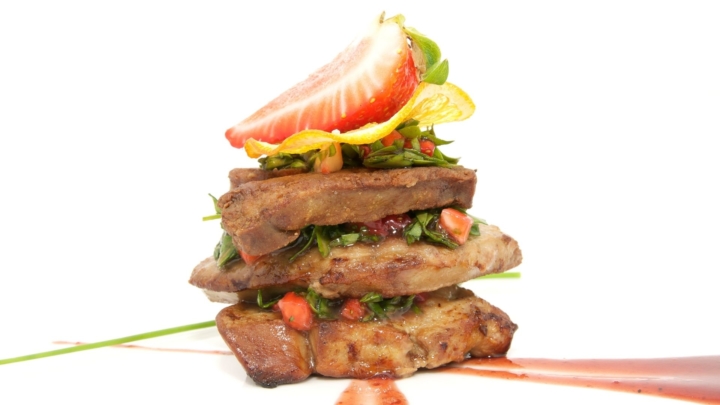
Fully cooked foie gras is the classic foie gras that has been cooked in a bain-marie at a temperature between 90 and 110°. This is the most traditional way to prepare foie gras, the product is preserved in its own fat and sterilized; this type of foie gras will keep for a long time in a dark and cool place.
Like wine, foie gras confit ages gracefully. Packaged in tubes or a classic farmhouse style jar.
As far as cooking is concerned, goose foie gras has the advantage of reducing its size less when cooked. A duck foie gras should normally weigh at least 300 g and a goose foie gras should weigh at least 400 g. The goose liver is therefore larger than the duck liver and in addition, it will hardly melt when cooked. Unlike duck foie gras. It is also for this reason that goose foie gras remains an excellent product.
Aesthetically speaking, duck foie gras looks more appetizing with its beautiful beige-orange color. Uncooked, goose foie gras has a pretty pink color but the color becomes a little duller once cooked, with slightly gray tones.
Goose or duck foie gras, it will depend entirely on your personal taste. However, if you are a fan of fine taste and if the less aesthetic side of cooking does not put you off, then the delicate and refined taste and the subtle flavor of goose foie gras will satisfy you perfectly. On the other hand, if the aesthetic side is very important, and you prefer more pronounced tastes, then the beige-orange color and the rustic touch of duck foie gras will suit you better.
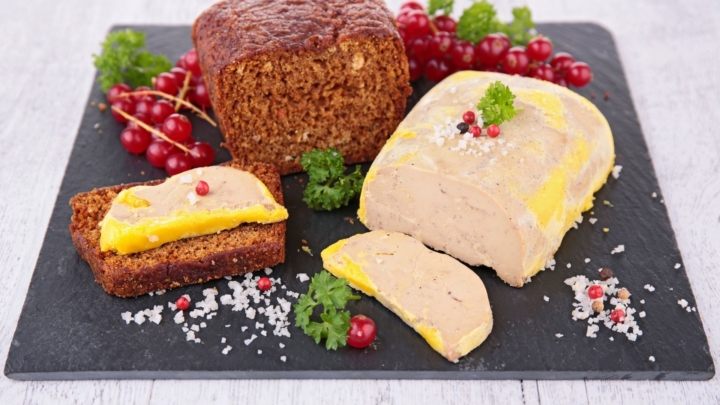
Foie gras, despite its name and its richness, is not as bad for your health as you might think:
There, now you'll feel better knowing that the main component of your holiday meal won't be as catastrophic to your body as you thought. You'll get a lot of calories, sure, but also vitamins and unsaturated fatty acids that will have very beneficial effects on your heart.
In our opinion, the best brands of foie gras in 2022 are :
It is a French brand that operates in the food industry and markets foie gras and gourmet boxes. It has existed for several years and is very popular with the French. This brand produces foie gras in blocks, whole foie gras and baskets.
This French brand is one of the high-end foie gras brands from France. Since its existence, the brand has never stopped offering noble products with exceptional tastes. It offers the best products for its consumers because it aims at excellence and durability of its products.
It is an industrial company specialized in the sector of activity of processing and conservation of poultry meat. Its products are very well treated and follow the standard required by the marketing of preserved meat in the UK and on the European scene.
This brand of foie gras specializes in duck foie gras. It values the know-how, the tradition and the good taste of the craft and that conforms to the required standards. This French brand has its notoriety and it even won the second place in the agricultural contest of Paris in 2012 by bringing back the silver medal.
This brand is famous for the authenticity and the typicity of its products. It values its relationship with its consumers by offering them quality products that come from livestock or crops that respect the cycles of nature that reassure its customers by their authenticity.
The diagram below will help you to get an idea of the typical prices for each price range (entry-level, mid-range and high-end).
However, more expensive does not necessarily mean better.
We therefore advise you to always consult our ranking before deciding, rather than blindly relying on price ranges.
Foie gras is best served cold
But not too cold: it should be cold, but not icy, this will enhance its aroma and creamy texture. Place the can or jar of foie gras in the refrigerator for a few hours, but take it out at room temperature half an hour before serving.
Pull your foie gras from its can one to two hours before serving
If you bought canned foie gras, remember to remove it from the can one to two hours in advance and put it back in the refrigerator, in a covered glass or porcelain dish. This will allow it to release its full flavor.
Be very careful when removing your foie gras from its can or jar
To more easily remove the foie gras from the can, open both ends and use one end to push the foie gras through the cylinder or tunnel. If the foie gras was in a glass jar, dip the blade of a knife in hot water, wipe it off and slide it between the glass walls of the jar and the foie gras. Apply these simple tips and your foie gras will look as appetizing to the eyes as it does to the mouth.
Remove excess fat, but don't be overzealous
Cut the foie gras at the last moment, using a knife with a thin, straight blade; dip it in hot water and wipe it clean after each slice. Or use a cheese wire. Arrange the slices on a cold plate or cold serving plates.
Serve foie gras with plain bread
A country bread or baguette, possibly lightly toasted, will enhance the flavor of the foie gras while fancy breads will mask it.
The answer is yes. You can buy raw foie gras and cook it yourself, but first you have to devein it so that you can slice the cooked foie gras evenly. Then you have to cook it slowly in a bain-marie over low heat (about 12-14°C) to prevent the liver from producing too much fat. Then let it rest for at least 3 days in the refrigerator before serving it. The advantage of cooking your own foie gras is that you can season it as you wish.
Fruit goes perfectly with foie gras, whether in jam or compote. You can serve it with figs, pears, grapes or dates.
As for drinks, foie gras goes very well with sweet wines like Sauternes, Jurançon, Monbazillac... You can also enjoy it with champagne.
It's always better to use fresh foie gras, but it's better to freeze it than to throw away good food! The process of freezing/thawing causes the cell walls to break down, and this is more noticeable in foods with high moisture content. There will be a loss of texture in a frozen/thawed foie gras. If the intention is to use it in a high temperature preparation, this is not really a problem: searing the slices will firm them up a bit. But I don't recommend using frozen/thawed liver to make a terrine: the texture will be grainy and the liver will tend to fall apart when you slice it.
As you browse through sautéed foie gras recipes, you'll probably notice that some ask you to flour your foie gras before searing it, while others do not. You may ask: what difference does it make? Not much. The idea behind flouring the foie gras before searing it is that it will make a nice crispy exterior that will contrast with the soft, silky interior texture. This contrast is indeed desirable, but you can also achieve this result by searing your slices very quickly over high heat. The only situation where the flour step is really necessary is when the recipe calls for mixing the flour with many different spices: this way, you will get a more even distribution of seasonings on all sides of the foie gras.
Every month we help more than 1 000 000 people buy better and smarter.
Copyright © 2022 - Made with ♥ by buyingbetter.co.uk
Your reviews and buying guides 0% advertising, 100% independent!